Hands on with the ASUS Fonepad, and ASUS PadFone Infinity
by Brian Klug on February 25, 2013 7:08 PM EST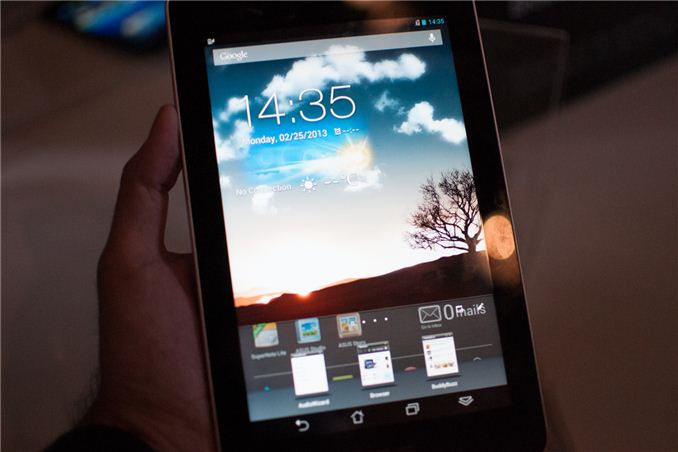
In its annual tradition at MWC, ASUS held a press conference off-site to introduce some of its mobile devices. The introductions are always interesting and typically unique in the marketplace. This year was no different.
To kick things off, ASUS introduced the Fonepad: a 7-inch Android 4.1.2 tablet that also serves as a phone. Samsung launched the Galaxy Note 8.0 earlier this week with a similar capability. While I don't expect many folks to want to hold a 7-inch tablet up to their face, having the ability to combine both tablet and smartphone functionality into one can be tempting. I can see the Fonepad being compelling if you don't make calls all that often but would rather carry a small tablet than a large smartphone, or if you are fine using a Bluetooth headset.
The device is pretty much a Nexus 7 but with a nice metal back. The dimensions are near identical to the Nexus 7 at 196.4mm x 120.1mm x 10.4mm with a weight of 340 grams. The display resolution remains 1280 x 800 and the IPS panel is LED backlit.
In a curious change of pace, ASUS integrated Intel's Atom Z2420 SoC (single-core + HT, 1.2GHz 32nm, PowerVR SGX 540). I'm curious to see how the single core, low-clocked Atom SoC does compared to Tegra 3 in a tablet. Driving all phone functionality is Intel's XMM 6265 baseband, with support for 850/900/1900/2100MHz WCDMA and 850/900/1800/1900MHz EDGE/GSM bands. There's support for 802.11b/g/n and BT 3.0.
The Fonepad features 1GB of LPDDR2 memory and 16GB of NAND on-board, with a microSD slot for additional storage expansion (a notable absence from the Nexus 7). There's an integrated 16Wh battery (like in the N7) and the device will be available in titanium gray and champagne gold (like the Transformer Prime).
The big selling point of the Fonepad is its price: $249. That's a pretty impressive deal for a full featured smartphone and 7-inch tablet in one. It's a bit of a quirky product, but I can definitely see the Fonepad filling a niche.
Next up is the ASUS PadFone Infinity. For those of you who aren't familiar with the PadFone concept, it's pretty simple. Take a phone that can dock into and power a tablet display and you have PadFone. The tablet part is strictly a display + battery, all compute and connectivity is driven by the phone element.
The PadFone Infinity takes a 5-inch 1080p Snapdragon 600 based smartphone running Android 4.2 and pairs it with a 10.1-inch 1920 x 1200 tablet dock (the PadFone Infinity Station). The phone weighs 141g and features an integrated 2400mAh battery, while the tablet dock weighs 530g and comes with a 5000mAh battery.
The phone integrates 2GB of LPDDR2-1066, and will come in both 32GB and 64GB versions. ASUS claims support for 802.11b/g/n and 802.11ac with WiFi Direct, BT 4.0 and NFC. Thanks to Qualcomm's baseband, there's full DC-HSPA+ and UE category 3 LTE support.
The PadFone features a 13MP rear facing camera with f/2.0 aperture lens and a 2MP front facing camera. When in tablet mode, the rear camera remains unimpeded while the front camera is replaced with a 1MP module.
Video out is supported via a Mobility DisplayPort interface (MyDP) that runs over the standard micro-USB port on the PadFone.


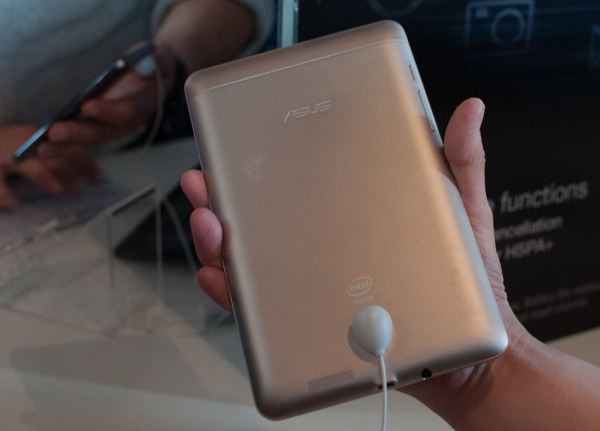

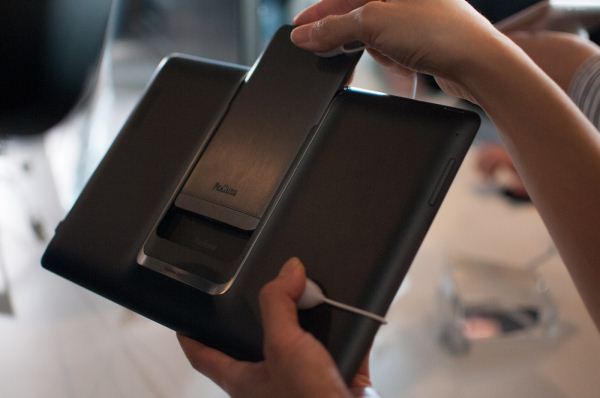
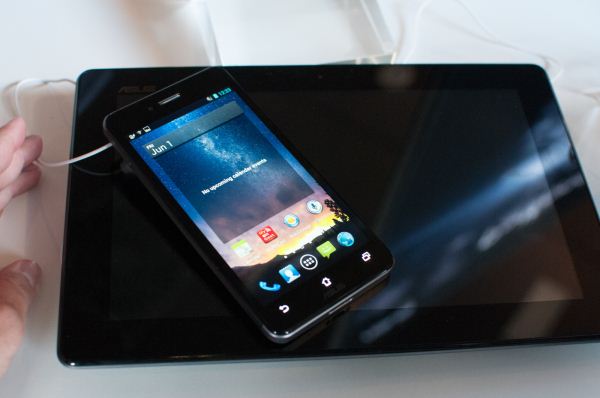
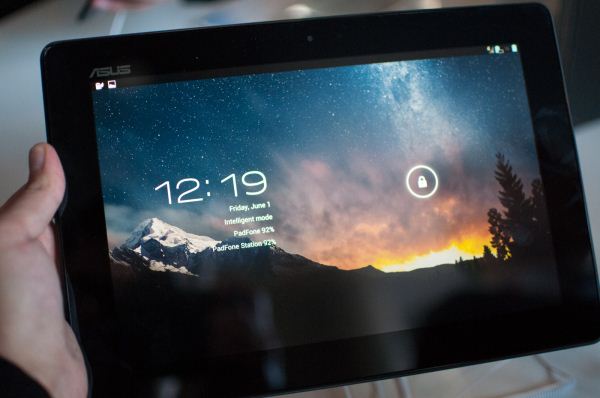














69 Comments
View All Comments
wsw1982 - Friday, March 1, 2013 - link
The Atom is fast than any duo-core A9, and maybe little bit slower to the quad-core A9.http://www.fonearena.com/blog/61522/xolo-x500-benc...
The A7 is less powerful than A9 but use less area.
So, you are right, the Lexington is little bit slower than tegra 4i, but the Lexington is targeting the phone less than 200$. I don't doubt that if the tegra 4i phone will be a good sell if they are below 200$, how much chance do you think that can happen?
As for A15, the only available A15, Samsung E5250, is fast, great, fantasy and power hungry. With 4+w power budget, it no doubt can beat the 2+w ATOM. If Samsung scale it up to 200W, and cooling it with Liquid nitrogen, it could probably beat 17w i7 as well :)
Wilco1 - Friday, March 1, 2013 - link
Again your link doesn't prove at all than a Z2420 is any faster than any A9. I showed how you were wrong about Vellamo already.At 2.3GHz a Tegra 4i is obviously much faster than a Z2420, even single threaded, so it will be used in high-end phones as it is the fastest A9 based SoC. As for cost, Tegra 3 was estimated at $22. Intel typically charges far more for Atom, so the reason Atom ends up in low-end devices is not because they are cheap...
It's true the Exynos 5250 uses a lot of power, but it is several times faster than an Atom so completes tasks quicker. Note the new Octa core reduces power consumption to ~1.25W per core at 1.8GHz according to Anand. We'll find out soon how it does in the Galaxy S4.
evonitzer - Tuesday, February 26, 2013 - link
Agreed. This reflexive Atom hate is perplexing. It's a bit of a CPU powerhouse, and glance at the Nexus 4 review charts again if anyone has forgotten.Wilco1 - Tuesday, February 26, 2013 - link
If it is a bit of CPU powerhouse, do you bet on it powering the Galaxy S4? Or any other high-end phone/tablet for that matter? My feeling is that chance is close to zero.The hard fact is that Atom is an old slow in-order microarchitecture that has been lagging in performance since out-of-order A9 and Krait came out. It'll be another year before a new Atom generation will end up in products...
smartypnt4 - Wednesday, February 27, 2013 - link
Yeah, no. That single core Atom wasn't ever destined to power something like the GS4 for a variety of reasons.Clover Trail+ on the other hand, mates 2 Atom cores at 2.0GHz to an SGX544MP2 that I'm sure has been clocked at over 500MHz becahse that's what Intel does. That could power a flagship-level device, and it does: see the Lenovo K900. It won't be a popular flagship, but it's still an important design win for Intel.
Valleyview will be far better though. I'm personally waiting for that since that'll be Intel's first core purpose-designed for phones. The current Medfield parts are adapted from their netbook effort, which was adapted from the Pentium 4 core, and is a bit ridiculous in this day and age.
evonitzer - Wednesday, February 27, 2013 - link
You're talking design wins, which I'd argue has more to do with Intel lacking a single chip LTE solution than the performance of its CPU. Notice this device lacks LTE, which would be unacceptable in a top of the line phone (except the Nexus 4, which is sorta midrange-ish).Still though, not all devices need to be top of the line, so I'd argue a $250 tablet (with low-ish resolution) is a fine place for the Atom chip.
Wilco1 - Tuesday, February 26, 2013 - link
Medfield is only competitive with a single A9 core at a low frequency. And even then it really only looks alright on SunSpider (which is not a CPU benchmark).If you want an idea how far Atom was behind a year ago, check out the Geekbench score of the 1.6GHz Z2460 in the Xolo vs the 1.4GHz Exynos 4 in Galaxy S3:
http://browser.primatelabs.com/geekbench2/compare/...
Note only does it achieve less than half the overall score, it loses every single threaded integer and floating benchmark except for one - despite its higher clockspeed. So we can safely conclude that an A9 is much faster than Atom, agreed?
Tegra 4 has a Geekbench score of 4285, so at 1.2GHz the Z2420 will be 6.5 times as slow. Using a single in-order core at 1.2GHz in 2013 is just insanity.
smartypnt4 - Wednesday, February 27, 2013 - link
Alright, first of all, please never say something is "6.5 times slower" than something else. There's no good way to interpret what you mean there.Now, I will admit that I was unaware of those benchmark figures. Those benchmarks indicate that a single Atom core is slower than the A9, I admit. The only area where I see a possible disagreement with that assertion is in the Stream benchmarks, which measure Floating point math and sustained memory bandwidth.
In those, a single core Atom CPU with hyper-threading beats the Exynos 4412. Now, the Floating Point benchmarks indicate that a single A9 is slower than an Atom core. So, how do we explain why the Atom is faster, having only 1 hyper-threaded core to the 4412's 4 cores? Simple: sustained memory bandwidth.
Extrapolating from that, I imagine that the browser-based benchmarks that I had most recently looked at are heavily memory-performance bound, which is why the RAZR i does so well in Kraken and Octane. Not having played with a device running an Atom chip, I can't speak to how much that extra memory performance helps the device's "feel" so to speak, but I've not ever seen a reviewer call a device with an Atom chip in it slow.
In essence: I apologize for immediately writing you off without having done my homework. However, the Atom SoC's memory subsystem keeps it on par in some respects with the best-of-the-best Android SoC's. In any case, I had no intention of besmirching your honor, but Atom's poor computational performance is hidden by what I can only imagine is its memory subsystem. I now really want an Atom-based device to see if the individual core's computational performance impacts the performance of my phone in my use case.
And yes, using an in-order core in 2013 is a bit absurd, but that's hidden by the hyper-threading to an extent. Not fully, but it helps. Clover Trail+ gives excellent results from AnTuTu (~27k from what I've heard, which is faster than the S4 Pro based phones). That's not Tegra 4 level, but then again, nothing that's been benchmarked gives anywhere close the T4 levels of performance. Anyway, I'll be interested in two things this year: Intel's Valleyview, which will be OoO and (hopefully) 22nm, and should release for the holiday refresh, and T4's memory performance. The Tegra 3 was hamstrung by its memory controller; I'll be interested to see what NVIDIA did to fix that.
Anyway, sorry for the misunderstanding. Hope the discussion has been as enlightening for you as it has been for me haha.
Wilco1 - Thursday, February 28, 2013 - link
Sorry, what I meant was that the Z2420's score will be about 1/6.5 that of Tegra 4, ie. Tegra 4 is 6.5 times faster in Geekbench.Exynos 4 is indeed slower than the Atom on Stream. This is not a memory bandwidth issue (as it is 20% faster in the memory test), but actually an issue with memory prefetching on current A9's. It is fixed in A9 R4 (Tegra 4i) and in Cortex-A15. For example Exynos 5250 now has twice the stream performance of the fastest available CloverTrail Atom:
http://browser.primatelabs.com/geekbench2/compare/...
No need to apologize, you're right that Atom has good memory performance. However while having good memory performance is important, that alone isn't enough. A lot of tasks require significant CPU and GPU performance as well. So how it translates to your device depends on how you use it. If you do a lot of browsing I'd say that BrowserMark is more appropriate than SunSpider (read my other post on SunSpider and other JS benchmarks).
Valleyview will be interesting as the claims are up to 2.7GHz quad core (but no HT) on 22nm. However release date now seems Q1 2014 according to leaked slides, so it is a year away. I don't expect Samsung, Qualcomm and NVidia to stand still in the meantime!
smartypnt4 - Thursday, February 28, 2013 - link
I'm the first to admit that more CPU and GPU performance is a good thing (especially GPU). I was just completely unaware that the reason Atom benchmarks so well is due to the prefetcher. I knew A9's had some pretty bad memory issues in certain respects, but I had forgotten where they fell down.I'll be interested to see what tech Valleyview actually contains. If we see Core-i series branch recovery and schedulers, this holiday season (which I believe is still being targeted for the very first products) and next Q1 could get interesting. But you're right; NVIDIA and Qualcomm won't stand still, that's for certain.
I would really love to see a 10W Core i-series chip (any of them) be benchmarked in the same system with the same OS as a Tegra 4, Exynos 5250, or Snapdragon 800. That's what I'm waiting for. But I doubt I'll ever get to see such a report. I still have doubts about comparing Geekbench scores across platforms. I'm not really sure that it's fair to do that given the different OS-level optimizations, etc.